#...austronesian language family
Explore tagged Tumblr posts
Text
going insane over jon jon briones's hermes when he's saying "no, anak" to orpheus
#found an audio of him on twitter saying that#got me thinking why he said 'no child' in bahasa indonesia for a moment#before I realized that he's filipino-american#...austronesian language family#Hadestown
14 notes
·
View notes
Text
Ohhh should I learn portuguese or indonesian next .......
#long long goal bcs im still just beginning japanese lolz#but still.... I have many reasons for both#I have friends who speak both... portuguese wld be easier bcs I already know spanish#but indo has an easier verb system so only vocab would be my main problem.....#indo is also a new language family which can help jf I want to learn other austronesian languages .......
4 notes
·
View notes
Photo

Polynesian Navigation & Settlement of the Pacific
Polynesian navigation of the Pacific Ocean and its settlement began thousands of years ago. The inhabitants of the Pacific islands had been voyaging across vast expanses of ocean water sailing in double canoes or outriggers using nothing more than their knowledge of the stars and observations of sea and wind patterns to guide them.
The Pacific Ocean is one-third of the earth's surface and its remote islands were the last to be reached by humans. These islands are scattered across an ocean that covers 165.25 million square kilometres (63.8 million square miles). The ancestors of the Polynesians, the Lapita people, set out from Taiwan and settled Remote Oceania between 1100-900 BCE, although there is evidence of Lapita settlements in the Bismarck Archipelago as early as 2000 BCE. The Lapita and their ancestors were skilled seafarers who memorised navigational instructions and passed their knowledge down through folklore, cultural heroes, and simple oral stories.
The Polynesian's highly developed navigation system impressed the first European explorers of the Pacific and since then scholars have been debating several questions:
was the migration and settlement of the Pacific islands and into Remote Oceania accidental or intentional?
what were the specific maritime and navigational skills of these ancient seafarers?
why has a large body of indigenous navigational knowledge been lost and what can be done to preserve what remains?
what type of sailing vessels and sails were used to cross an open ocean?
Ancient Voyaging & Settlement of the Pacific
By at least 10,000 years ago, humans had migrated to most of the habitable lands that could be reached on foot. What remained was the last frontier – the myriad islands of the Pacific Ocean that required boat technology and navigational methods be developed that were capable of long-range ocean voyaging. Near Oceania, which consists of mainland New Guinea and its surrounding islands, the Bismarck Archipelago, the Admiralty Islands, and the Solomon Islands was settled in an out-of-Africa migration c. 50,000 years ago during the Pleistocene period. These first settlers of the Pacific are the ancestors of Melanesians and Australian Aboriginals. The small distances between the islands in Near Oceania meant that people could island-hop using rudimentary ocean-going craft.
The so-called second wave of migration into Remote Oceania has been an intensely debated scholarly topic. Remote Oceania is the islands to the east of the Solomon Islands group such as Vanuatu, Fiji, Tonga, Aotearoa (New Zealand), Society Islands, Easter Island, and the Marquesas. What is debated is the origins of the first people who settled in this region between 1500-1300 BCE, although there is general agreement that the ancestral homeland was Taiwan. A dissenting view has been that of Norwegian adventurer Thor Heyerdahl (1914-2002 CE) who set out in 1947 CE on a balsa raft called Kon-Tiki that he hoped would prove a South American origin for Pacific islanders. Archaeological and DNA evidence, however, points strongly to a southeast Asian origin and seafarers who spoke a related group of languages known as Austronesian who reached Fiji in 1300 BCE and Samoa c. 1100 BCE. All modern Polynesian languages belong to the Austronesian language family.
Collectively, these people are called the Lapita and were the ancestors of the Polynesians, including Maori, although archaeologists use the term Lapita Cultural Complex because the Lapita were not a homogenous group. They were, however, skilled seafarers who introduced outriggers and double canoes, which made longer voyages across the Pacific possible, and their distinctive pottery – Lapita ware – appeared in the Bismarck Archipelago as early as 2000 BCE. Lapita pottery included bowls and dishes with complex geometric patterns impressed into clay by small toothed stamps.
Between c. 1100-900 BCE, there was a rapid expansion of Lapita culture in a south-east direction across the Pacific, and this raises the question of intentional migration.
Continue reading...
55 notes
·
View notes
Text
A lot of those who insist that Filipinos are Pacific Islander instead of (or, in addition to) Asian often rely on loose interpretations of the term Pacific Islander and the fact that the Philippines was used as a stepping stone in the Austronesian expansion to the east. What they ignore or may not know is that (1) the superficial similarities between Pacific Islanders and Filipinos are not unique to Pacific Islanders and Filipinos but with Austronesian-speaking peoples in general, including Austronesian-speaking Southeast Asians and (2) we Filipinos simply did not have as regular and as vigorous a contact with the Pacific Islands - if any - compared to the Asian continent. We still don’t.
Think about it: the earliest known trade network in the Philippines included what is now Taiwan and Southeast Asia, i.e., the Philippine jade culture which dates as far back as 2000 BC and lasted for 3,000 years. Nephrite jade from Taiwan was manufactured in the Philippines and distributed elsewhere in the nearby region. After that were the Sa Hu���nh-Kalanay Interaction Sphere from 500 BC through AD 100 and of course the so-called Maritime Silk Road during historical times. What followed was then the very familiar colonial era of Iberian, Dutch, and British presence in Asia.
The earliest Filipino artifact with a given calendar date is the Laguna Copperplate Inscription which was written in the year AD 900 using a Brahmic script in a combination of Sanskrit, Old Malay, Old Tagalog and/or Javanese. Upon the arrival of Magellan six hundred years later in 1521, it was a man titled rajah who greeted him in Cebu. Half a century later, the aged grandson of the sultan of Brunei was ruling Manila. To this day, among the lesser Hispanicized and Americanized ethnic groups across the Philippines, the Ivatan of Batanes speak a family of languages shared with the Tao of Orchid Island, Taiwan and the people of Bangsamoro have more in common with Bruneians, Indonesians, and Malaysians than they do with the Māori, Kanaka Maoli, or Fijians. Indigenous Borneans are closely related to Filipinos.
As for myself, I was raised in Davao where you’ll find Cebuano, Ilonggo, Kagan, Maguindanaon, Maranao, Mansaka, Mandaya, Manobo, Bagobo, Chinese Hoklo, Japanese, and Indian people live; no one local I’ve ever met has identified as Pacific Islander and there was never a question as to whether I was Asian or not because I was surrounded by fellow Asians. It’s certainly hard to deny it when your country of origin is one of the founding members of the Association of Southeast Asian Nations, attempted to make a Malaysian-Filipino-Indonesian confederation happen, and contains the title “Pearl of the Orient” as a lyric in the national anthem.
Does this look like an archipelago that kept close touch with polities and cultures across the Pacific Ocean for thousands of years? Does this look like a society that is more Pacific Islander than Asian?
90 notes
·
View notes
Text
Ibaloi is a stable indigenous language of the Philippines. It belongs to the Malayo-polynesian branch of Austronesian language family. The language is thought to be used as a first language by all in the ethnic community in benguet province principally in the municipalities of Itogon (12,353), Tuba (11,063), La Trinidad (12,136), Bokod (8,911), Baguio (68,550), and Atok (9,063) (NSO 1980, 1990). The population has spread to the neighboring provinces of Pangasinan, La Union, Nueva Vizcaya, and Nueva Ecija. Kabayan is recognized as the center of Ibaloy culture according to NCCA.
Here are some of their rare word to hear:
Adibay - Pagkakasama-sama/Pagtitipon (Gathering, Reunion)
-This word refers to a gathering of people to enjoy each other's company.
Example: Keto jew kasal nen bing-ot, pan adibayan
Translation: let's go to the wedding of bing-ot, let's have a reunion
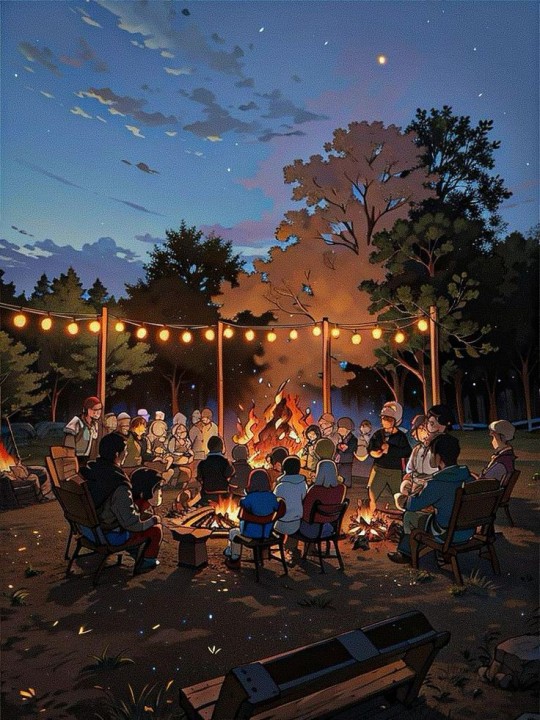
A-ki- kapatid (Siblings, Brothers and Sisters)
-This term describes a sibling relationship.
Example: Wag ka ng mahiya man-aaki ta jon amin shiyay
Translation: don't be shy we're all brothers and sisters here
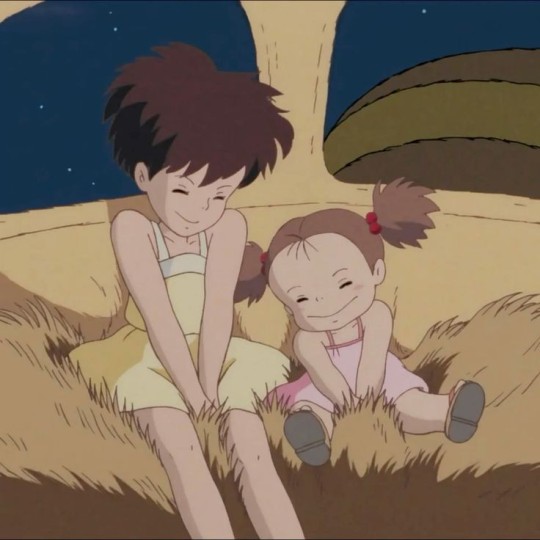
Manshejaw -magsimba
-This word is used to say that your going to church or inviting someone to go to church
Example: Undaw manshe-jaw
Translation: let's go to church

Tam-tamim - buti nga sayo
-This word is used to say that when something bad has happened to you or someone you say this to tell them that they deserve it
Example: Ahhh tam-tamim, kaka dukom itan nen shiela
Translation: You deserve that, that's what you get from cheating from shiela
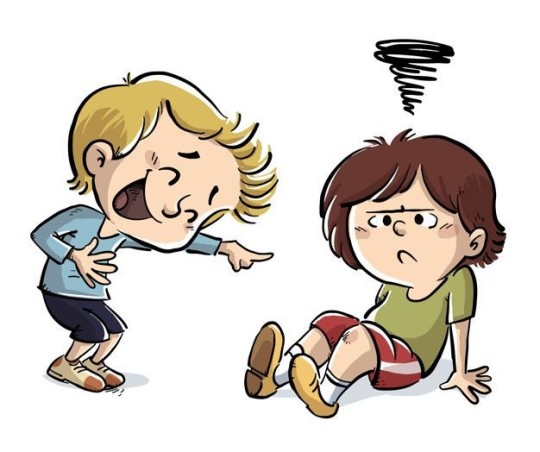
E-tuling - maitim
-This word describes something or someone with a dark color or complexion.
Example: E-tuling e color ni baro toh
Translation: The color of his shirt is dark

Ansemek taka- mahal kita
-This word is used to say your feelings to someone you love deeply
Example: Ansemek takan pasya marimar
Translation: I love you so much marimar

Konshavil- tsismosa
-This word is used to describe someone who loves to spread and feast on rumors
Example: Angsan itan ni pan ka konshavil mo marites
Translation: You being a goosipmonger is too much

Talimbaweng -lie
-This word means a lie or the act of lying.
Example: talimbaweng bengat i-tuka ikukuwan
Translation: Her words are lies

Eshonong- good behavior
-This describes someone with good manners and behavior.
Example: On em kari ira eshonong nu man ira, aligwan singan sikam
Translation: Look at them they are well behaved, unlike you

Pansigshan- ikakabuti
-This word indicates something will have a positive outcome.
Example: Pan ashal kan usto, pansigshan mo met lng itan
Translation: Study hard it will be for your own good

Remember each language and dialect is a vibrant language, reflecting a rich community. Let's work together and protect its unique voice.
20 notes
·
View notes
Text
Tongans

Tongans are a Polynesian ethnic group native to the Kingdom of Tonga, an archipelago located in the South Pacific Ocean. The Tongan people constitute a culturally rich and historically significant population that has maintained continuity through centuries of navigation, contact, and transformation. As of the early 21st century, Tongans number approximately 100,000 within Tonga itself, with a sizable diaspora numbering over 150,000 in countries such as New Zealand, Australia, and the United States. Tongans are part of the broader Austronesian ethnolinguistic family, with close cultural and linguistic ties to other Polynesian groups such as Samoans, Māori, and Hawaiians.

The ethnogenesis of the Tongan people traces back to the Lapita culture, a seafaring Austronesian people who migrated eastward from Island Southeast Asia and Melanesia into the Pacific approximately 3,000 years ago. The Lapita are considered the ancestral Polynesians, and archaeological evidence places them in Tonga around 900 BCE. Tonga, alongside Samoa and Fiji, formed the core region of the so-called Polynesian "cradle" from which subsequent migrations populated the remainder of Polynesia, including Hawaii, New Zealand, and Easter Island.
The early Tongan societies developed complex chiefdoms organized around kinship ties, religious leadership, and resource management. These societies eventually evolved into the highly stratified Tongan maritime chiefdom that dominated a large portion of western Polynesia, especially during the period of the Tu‘i Tonga Empire.

From the 10th century CE, Tonga became a center of political and cultural influence in the Pacific through the rise of the Tu‘i Tonga lineage. This line of sacred rulers established a form of paramount chiefdom which expanded Tongan influence across much of Polynesia and parts of Micronesia and Melanesia. Oral traditions and archaeological evidence suggest the existence of tribute relationships, intermarriages with foreign elites, and a diffusion of Tongan customs and religious practices.
The empire was at its height between the 13th and 16th centuries. Political power was gradually decentralized over time, with the creation of parallel chiefly lines, the Tu‘i Ha‘atakalaua and Tu‘i Kanokupolu, to manage growing administrative and political complexity. By the 18th century, the Tu‘i Kanokupolu line had become the primary locus of political authority, leading to eventual centralization under the Tongan monarchy.
European contact began with the visits of Dutch explorers Willem Schouten and Jacob Le Maire in 1616, followed by Captain James Cook in the late 18th century, who dubbed Tonga the "Friendly Islands" due to the initial hospitality he received. However, subsequent encounters were more complex, involving both violent conflict and deep cultural exchanges.
In the 19th century, missionary activity—primarily by the London Missionary Society and later the Wesleyan Methodist Mission—brought Christianity to Tonga, dramatically reshaping Tongan society. The conversion of King George Tupou I to Christianity facilitated the adoption of Western legal codes, education systems, and a constitutional monarchy modeled on British principles. The Tongan Constitution was adopted in 1875, and Tonga remains the only Pacific nation never formally colonized, although it became a British protected state from 1900 to 1970.

The Tongan language (lea fakatonga) is a Polynesian language belonging to the Austronesian family. It is closely related to other Polynesian tongues such as Samoan and Hawaiian but retains distinct phonological and grammatical characteristics. Tongan employs a subject-verb-object (SVO) word order and makes extensive use of pronouns to indicate number (singular, dual, plural) and inclusivity/exclusivity.
Language is a crucial carrier of Tongan culture and social structure, with specific registers of speech for use in formal, chiefly, or sacred contexts. English is also widely spoken, especially among younger generations and in the Tongan diaspora, and is an official language alongside Tongan.

Tongan society is hierarchically structured and deeply influenced by traditional kinship and chiefly systems. The fundamental unit of Tongan society is the extended family or kainga, which functions as a cooperative economic and social unit. Leadership within the kainga traditionally falls to the 'ulu (head), and familial responsibilities are distributed according to age, gender, and rank.
At the societal level, Tongans historically acknowledged a stratified system comprising the monarch (Tu‘i), nobility (hou‘eiki), and commoners (tu‘a). This tripartite social system persists in contemporary Tonga, particularly in land ownership and political representation. Nobles maintain significant influence and are represented in the Tongan Legislative Assembly.
Ceremonial exchange, particularly through the presentation of kava, mats (fala), and bark cloth (ngatu), underscores social obligations and status hierarchies. These rituals reinforce social cohesion and obligations within and across kin groups.

Tonga is an overwhelmingly Christian nation, with Methodism (primarily the Free Wesleyan Church) being the dominant denomination. Religious observance is central to Tongan identity, and Sunday is observed as a sacred day of rest, enshrined in the national constitution.
Traditional religious beliefs—centered on a pantheon of gods, ancestral spirits, and the concept of mana (spiritual power)—have largely been syncretized or replaced by Christian doctrines. However, vestiges of indigenous cosmology can still be seen in folklore, oral traditions, and cultural symbolism.
Tongan art reflects both utility and ritual significance. Traditional crafts include:
Ngatu (tapa cloth): Made from the bark of the paper mulberry tree and decorated with natural dyes, ngatu is used for ceremonies, gifts, and trade.
Lalava (plaited sennit lashings): Used in traditional architecture and canoe-making.
Fala (woven mats): Often made from pandanus leaves, fala are highly valued ceremonial items.
Tattooing (tatatau) was once a common cultural practice but declined due to missionary influence. However, there is a revival of interest in traditional tattooing in the diaspora and among cultural practitioners.
Tongan dance (lakalaka) is a highly stylized and prestigious art form performed at formal ceremonies and national celebrations. It combines poetry, choral singing, and synchronized movements to express historical, political, and moral themes. Other traditional dances include the ma'ulu'ulu (seated dance) and the tau'olunga, performed by young women to honor guests or mark important events.
Music in Tonga traditionally involved nose flutes, drums, and vocal harmonies. Today, Christian choral music, brass bands, and contemporary Polynesian pop coexist with traditional forms.

Tongan cuisine is based on root crops such as taro, yams, cassava, and sweet potatoes, often complemented by seafood (octopus, fish, shellfish) and pork. Coconut cream is a ubiquitous ingredient, used to flavor stews and desserts.
Popular dishes include:
Lū pulu: Corned beef wrapped in taro leaves with coconut cream.
Ota ika: Raw fish marinated in citrus juice and coconut cream.
Feke: Grilled or stewed octopus.
Faikakai: Dumplings in sweet coconut syrup.
Feasting is central to social life, with large communal meals ('umu, or earth ovens) prepared for weddings, funerals, and church events.

Although the population of Tonga is small, the Tongan diaspora has had an outsized influence on global Polynesian communities. Large Tongan populations are found in Auckland, Sydney, and various American cities such as Salt Lake City and Los Angeles. Migration has historically been driven by economic opportunities, educational pursuits, and family reunification.
Remittances from the diaspora are a crucial component of Tonga’s economy, accounting for a significant portion of national income. The diaspora also plays an important role in cultural preservation and adaptation, with churches, dance groups, and language schools operating abroad.

Tonga is a constitutional monarchy, with a hereditary king, a parliament, and a system of nobles who hold both ceremonial and political power. The political system has undergone reform, particularly since the 2006 pro-democracy protests, leading to increased representation of commoners in the Legislative Assembly.
The monarchy remains a central symbol of national identity, and the king is regarded with reverence and loyalty. Land ownership is legally reserved for nobles and their descendants, although commoners have usufruct rights.

Tonga’s economy is classified as developing, with agriculture, remittances, and foreign aid forming the backbone of national income. Key agricultural products include squash (for export to Japan), coconuts, vanilla, and root crops. The country’s small industrial base is supplemented by tourism and seasonal labor schemes with Australia and New Zealand.
Challenges include geographic isolation, vulnerability to natural disasters, and dependence on external sources of income. However, efforts are ongoing to promote sustainable tourism and increase digital connectivity.
Tonga provides free basic education and has relatively high literacy rates. The education system combines local and foreign curricula, and many Tongans pursue higher education abroad. Schools often incorporate both academic and cultural instruction, including Tongan language, history, and religious education.
Health indicators show a mix of successes and challenges. Tonga has a functional public health system, but non-communicable diseases such as diabetes and cardiovascular conditions are prevalent, largely due to changes in diet and sedentary lifestyles. Public health campaigns focus on lifestyle diseases, maternal health, and vaccination coverage.
Tongans represent one of the most enduring and culturally rich peoples of Polynesia. Through centuries of adaptation, seafaring innovation, religious transformation, and global diaspora formation, Tongans have maintained a coherent identity rooted in kinship, language, and cultural pride. Their contributions to Pacific history, both ancient and modern, mark them as a resilient and dynamic people deeply interwoven with the broader narrative of Oceania.
#tonga#tongans#polynesia#polynesian culture#pacific islands#oceania#ethnography#cultural anthropology#indigenous peoples#austronesian#traditional culture#pacific culture#tongan heritage#south pacific#island culture#tumblr academia#anthropology#history of the pacific#diaspora studies#tongan pride#cultural preservation#traditional clothing#pacific studies#oceanic art#tongan language#ethnic studies#tongan history#polynesian pride#tongan tattoo#folk culture
7 notes
·
View notes
Text
untuk hari bahasa ini, saya cubalah mengajarkan semua tentang sikit budaya melayu dan berkongsi kosa kata juga (ENG TRANSLATION)
(for this language day, I will try to teach a little about Malay culture and share vocabulary as well)
i made the original post detailing some fun stuff abt my culture of being malay (specifically from perspective living as a Malay from Singapore), i want to do an english translation so its more accessible to those who don't speak malay. This isnt an exact translation (plus im adding mroe additonal info) so keep that inmind
FIRST, what is the Malay language? This is an Austronesian language, also the national language in Brunei, Malaysia and Singapore. Malay is usually written in Latin script, also known as Rumi. There is also Jawi script based on Arabic writing. If you want to know (most) letters in Jawi, this is a video stuck in my head from Andalus (I'm bad at writing in Jawi and Arabic too, even though I study, I don't know much;;;)
Malay culture is deeply connected with Muslim culture, that's why a lot of malay festivities and celebrations revolve around the islamic calender. one such celebration is Hari Raya. there are two ceremonies; Aidilfitri and Haji, I will talk about Hari Raya Aidilfitri only because it is close this year and most well known (for context, its litterally in april this year).
The previous month is Ramadan where we fast/puasa. We do not eat from Subuh (around sunrise) to Maghrib (around sunset) (these are two of the names of the prayer times, in Islam we are supposed to pray around 5 times a day during different intervals. it goes Subuh, Zohor, Asar, Maghrib, Isyak). Before dawn, want to eat Sahur and then pray. At Maghrib, want to eat to break the fast/ berbuka puasa (usually say "buka" for short). Also in this month before Aidifilti, the family will prepare by cleaning the house for visitors, buy new baju kurung, get kuih, etc etc.
aaaa there are a lot of kuih, here's anything I can name (many are from Singapore); kuih lapis, kuih salat? ondeh ondeh, kuih bahulu, kuih dadar, BISKUT CORNFLAKES OMG does that count?. there are many more lol.
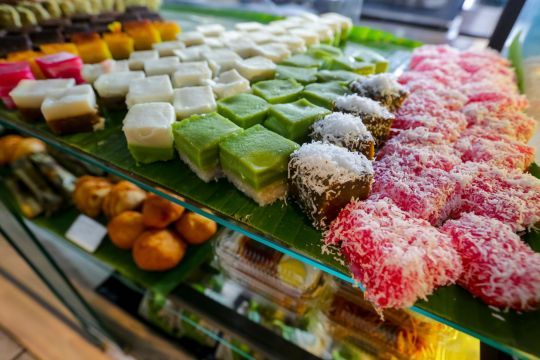
ALSO! In Singapore, during Ramadan, there is a huge Night Market in Geylang. Not only in Geylang there is a night market but this is very popular. There are MANY stalls selling food. Everyone who buys from geylang night market knows Ramly Burger, deep-fried Oreos, vadai, KEBAB, DENGDENG. (I like to buy rolled ice cream and chicken kebab mmmm)
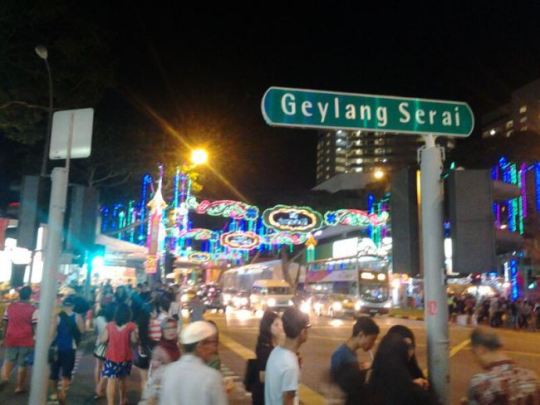
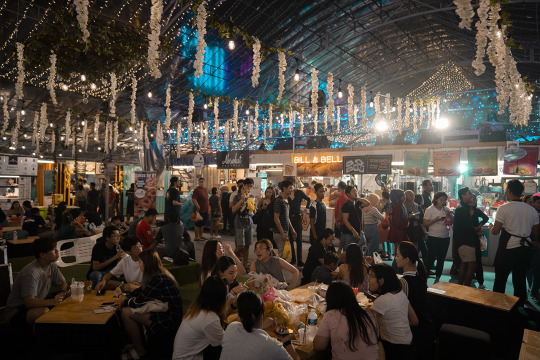
In Geylang too, they will buy traditional clothes to visit family. Baju kurung (ehh for traditional clothes, women wear baju kurung, men wear baju melayu but the names are the same anyway) is the normal clothing. Often, one household will choose to coordinate colors together (but it's not mandatory, lmao my family doesn't care)
For men, they wear songkok (that flat black hat) and samping (the long scarf wrapping around the waist)
For women, wear a sarong (skirt) with a long top. If desired, will also wear a tudung (type of hijab) (i should also clarify for muslim women its their choice whether they want to habitually wear hijab. its not just specific to just baju kurung. for example i have lots of aunties that dont wear hijab at all meanwhile i have a lot of aunts who do)
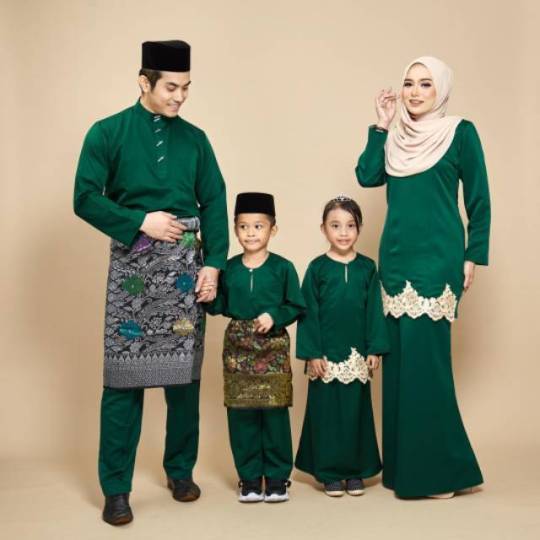
Baju kurung is also worn at other festivities, such as weddings
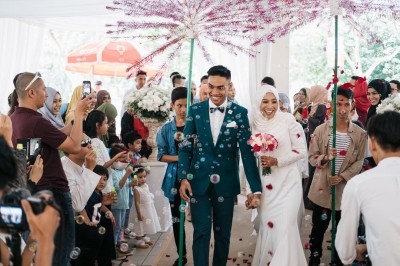

(my whole childhood I attended so many weddings, this is another topic lmaooooo)
On Hari Raya Aidifilti but before going to raya (this is what we generally call going out to see family), close family in will ask for forgiveness. (it's important the forgiveness is not one-sided, the adults will also ask forgiveness from the younger family members too). Usually this is when people start crying. After that, we go RAYA!!! When in someone else's house, if you are not working now, you can get duit raya! (because I grew up in singapore surrounded by chinese influence, I also call this "angpao" too)
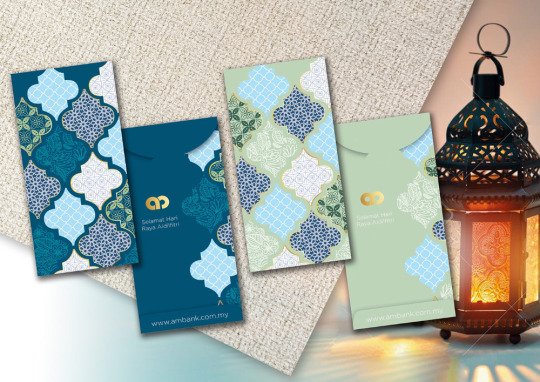
OHHHH THERE IS A LOT OF FOOD;;;; My grandmother would cook a lot during Ramadan and Hari Raya. Rendang, lontong, KETUPAT OHHH KETUPAT, CHICKEN CURRY (my mother every aidifitri cooks green chicken curry, FOR HARI RAYA AIDIFITRI ONLY, ohhhhh that's my favorite part, ASBFKASB I'M HUNGRY.)
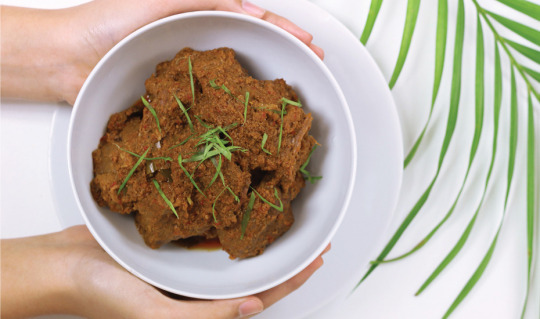

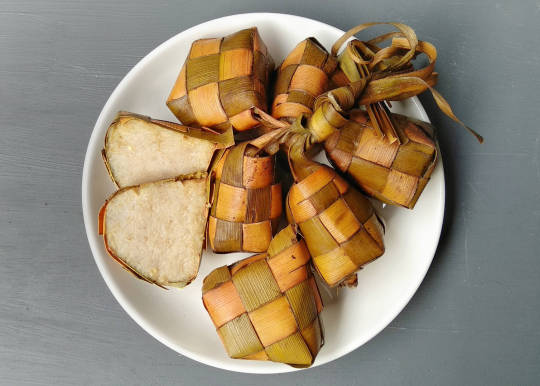

(theres also like way more cuisine than this, iu havent even mentioned nasi goreng and nasi lemak and briyani and FUCKIGN BEGEDIL;;;;)
ketupat is kind of icon to represent Aidifilti holiday, for example:

other icons of hari raya include: bunga api, neon string lights, bamboo torches, etc.
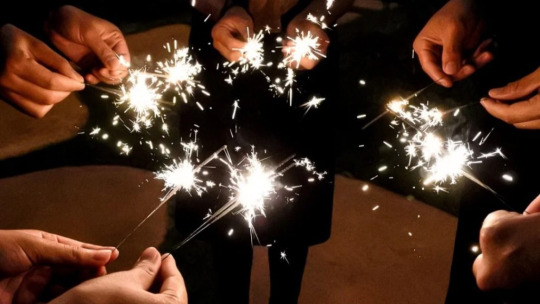
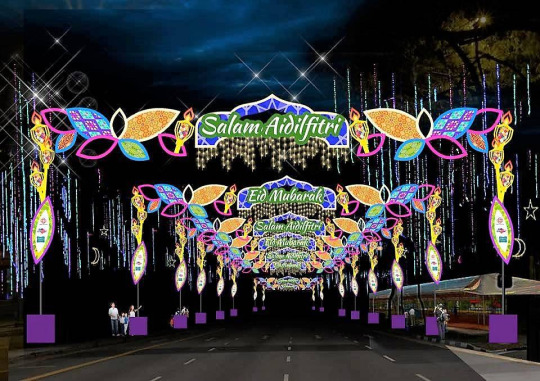

I love Hari Raya even thoug my feet hurt ALOT after visiting LOTS OF FAMILY AND FRIENDS OH MY GOD:;; it's okay if you take your shoes off in the house somehow your FEET WILL HURT at the end of the day;;;;;;
uhhhh others about malay culture? we have art! A martial art is silat melayu! I don't know much about this but it's great
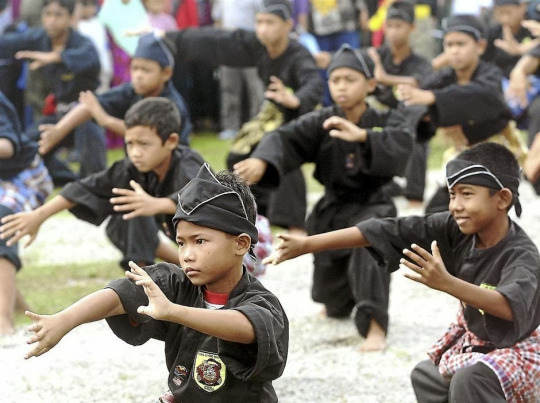
there is performance art: one example is dikir barat
youtube
juga ada permainan, ada yang terkenal ialah wau (kite)
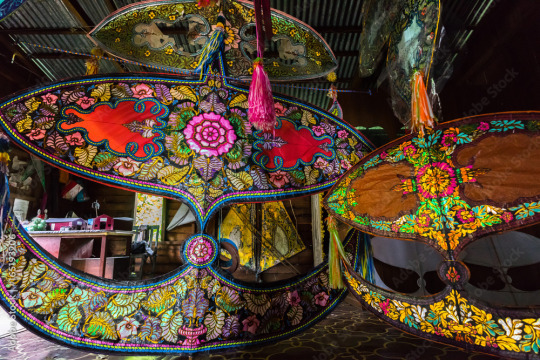
and congkak (like that one club penguin game, mancala, im not kidding)
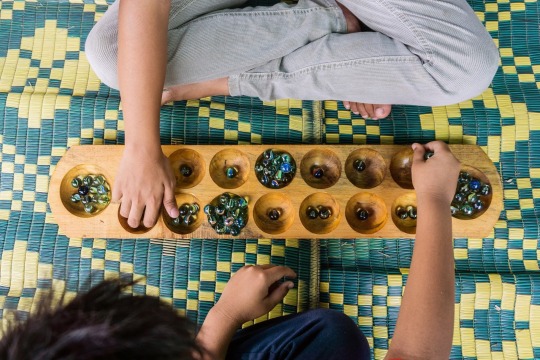

there are many malay cultures that are also from indonesian culture because of its influence. (Mainly malay culture was influenced by its neighboring cultures such as from Thailand, Sumatra, Java. Malay culture were from Hinduism before then converting to Islam) That's why we have wayang kulit (natively from Java) (a lot of indonesian culture and malay cultures share similar things because of kinda their similar roots and their spread of their own culture, hence why we also have similar dishes, traditonal clothes, even our language is kinda 70% the same)

Do you know; Singapore was discovered by Sang Nila Utama and was originally Malay kingdom (at that time the island was called Temasek before it was owned by the British) (the original indigenous of Singapore are called Orang Laut, litterally translated to "people of the sea"). That is why in Singapore, the language and the national anthem (Majulah Singapura) is in Malay. Singapore is not only for Chinese people, we Malays and Indians are also here;;;
(and im not at all from malaysia god please none of my relatives are. Malaysian is referring to the country, Malay is the language and the ethnic group)
There's a whole lot more I haven't even touched on, like lmao there's a whole thing about weddings and a whole baby shower thing.
theres also a lot of singaporean stuff i want to share i haven't even mentioned singlish but thats a post for another time
58 notes
·
View notes
Text
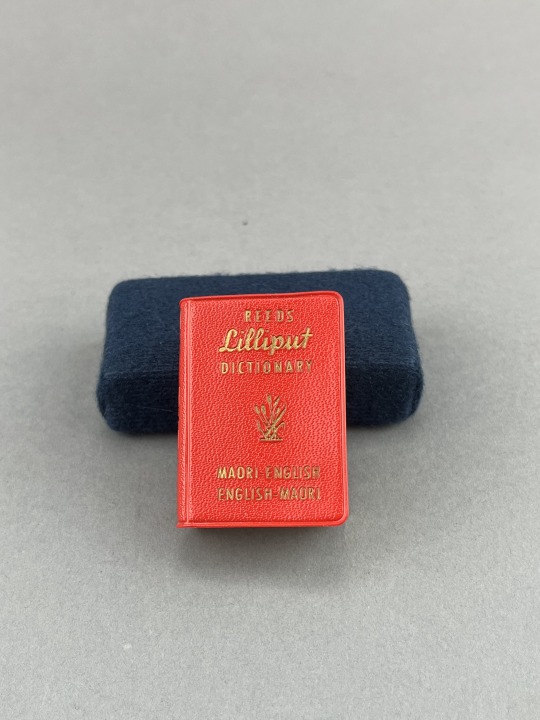

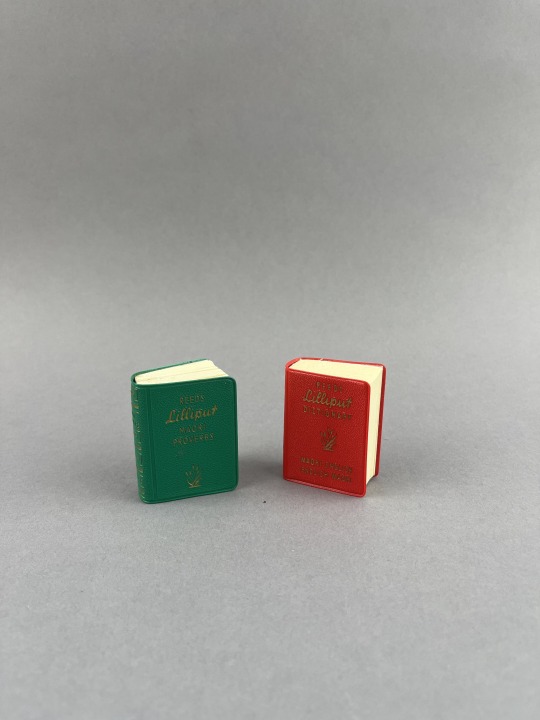
#MiniatureMonday
Happy Māori Language Week from Special Collections & Archives!
Te Wiki o te Reo Māori, Maori Language Week, is celebrated annually the week of September 14th to commemorate Te Wā Tuku Reo Māori, the Maori Language Moment, which stamps the presentation of the Maori Language Petition in New Zealand at 12 pm on September 14, 1972.
Te Reo Māori is the language of New Zealand's Indigenous Maori people. It is a part of the Austronesian language family and shares its roots with other island languages including Tahitian and Hawaiian. The celebration of Te Wiki is rooted deeply in efforts to revitalize the Māori language after years of the speaking and use of te reo was banned in schools. Today, te reo Māori is the official language of New Zealand, or Aotearoa as it is called by the Indigenous people. It has become increasingly used in New Zealand society, culture, and professional institutions. The Māori language has also become something of global interest, with the popularization of the language through its presence in music, film, television, and sports commentary.
In the United States, Polynesians as a whole make up less than half of a percent of the American population, with Māori people as one of the smallest migrant populations. Still, for those living abroad or interested in learning the language from afar, the language revitalization movement has certainly spread to the United States, along with its learning materials and resources.
There is a Māori proverb that reads ahakoa he iti he pounamu, "although it is small, it is greenstone." This refers to the importance of things small but precious, such as these miniatures!
The Reeds' Lilliput Māori dictionary and Reeds' Lilliput Māori proverbs live in Special Collections as part of the Smith Miniature Book Collection. These 5cm tall miniature books were published by A.W. Reed in the early 1960s, the dictionary in 1960 as part of a collection of miniature dictionaries made popular by other global publishers. The book of whakatauki, Māori proverbs, joined the mini-dictionary in 1964. Other language dictionaries include Spanish, French, and Romanian. Due to their size, it is likely that these books were made to entertain more so than educate. Still, they are certainly one of the many taonga, treasures, of Special Collections.
Te Wiki o te Reo Māori 2023 begins Monday, September 11, and concludes Sunday, September 17. Celebrate through songs, stories, conversations, or by learning some library-related Māori vocabulary! You can also visit the University of Iowa LibGuide on learning beginner's te reo Māori.
NGĀ KUPU WHARE PUKAPUKA LIBRARY VOCABULARY
pukapuka book
pūranga archive
whakaputunga collection
kaitiaki pukapuka librarian
wāhi tuku pukapuka reference desk
pānui to read
ako to learn
--From M Clark, Instruction GA
Reeds' proverbs (SMITH PL6465.Z77 .R44 1964) and Reeds' dictionary (SMITH PL6465.Z5 .R44 1960)
#uiowa#special collections#miniaturemonday#uiowaspecialcollections#rare books#library#maori culture#te reo maori#proverbs#new zealand
86 notes
·
View notes
Text
Diving into Ilocano: Words from the Heart

Ilocano is one of the oldest and third most common languages spoken in the Philippines. It is somewhat mutually intelligible with a few other languages on the islands. It is primarily used in northern regions like Ilocos Norte, Ilocos Sur, and parts of Cagayan Valley. It belongs to the Austronesian language family, which is shared by other Filipino languages like Tagalog and Cebuano
Let’s dive into these words that may not have a direct translation in English but are full of significance.
1. RIRIBOK
Definition: To distract or trouble someone.
Example: “Ririboken ni Nollan ti panagluto ni manang na.”
Translation: Nollan is distracting his Ate while she’s cooking.
2. NALIDAY
Definition: Sadness or the state of being sad.

Example: “Naliday ni Yleena nga madi nakaapan idi kasangay ni lakay na.”
Translation: Yleena is sad that she cannot attend her husband’s birthday.
3. AGSARDAY
Definition: To be stubborn or to refuse to follow instructions.

Example: “Agsarday ni Jenzel nga agsanay para iti CAVRAA 2025.”
Translation: Jenzel is stubborn and doesn't want to train for CAVRAA 2025.
4. INDENGAM
Definition: To endure or to bear something, especially hardships.

Example: “Indengam ti sakit ti ulo nga tugot ta panagayat mo itta nga lalaki.”
Translation: Endure the headache caused by your love for that man.
5. NARANGGAS
Definition: Careless, reckless.

Example: “Madim ikkan ti papeles ta naranggas ata nga tao.”
Translation: Don’t give the documents to her because she’s careless.
6. NAIBATANG
Definition: Assigned or designated to a task or duty.

Example: “Naibatangak nga agluto ti innapoy nu bigat.”
Translation: I was assigned to cook rice tomorrow.
7. LADINGIT
Definition: A feeling of bitterness, sorrow, or sadness.

Example: “Adda ti ladingit iti pusok nu panpanunutek nga ibati nak.”
Translation: There is bitterness in my heart thinking that you might leave me
8. AGULLA-ULLANG
Definition: To keep crying, often implying excessive or continuous crying.

Example: “Agulla-ullang ni Ico idi natiliw isuna ni baket na nga adda kadwa na nga sabali”
Translation: Ico keeps crying when he caught his wife with someone else
9. BURIBOR
Definition: To disturb someone or something that is still or quiet.

Example: “Ni Czarifa ket buribor ti panagaramid ni Aldrei ti pangaldaw da.”
Translation: Czarifa is disturbing Aldrei while he’s cooking their lunch.
10. KATANG-KATANG
Definition: A term used to describe a feeling of being stubborn, or hard-headed.

Example: “Katang-katang ata nga ubing! Madi na kayat ti agiskwela ti nasayaat.”
Translation: That kid is stubborn! She doesn’t want to study well.
That’s a wrap for today, Hope you learned something new and fun. If you liked this, don’t forget to hit that like button, and leave a comment with any words you want me to cover next!
TO LEARN HOW TO PRONOUNCE SOME DEEP ILOCANO WORDS, CLICK THE LINK BELOW! 👌🏻
youtube
5 notes
·
View notes
Text
Most commonly spoken language in each country
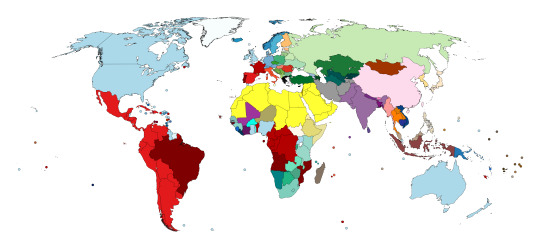

I had to separate the legend from the map because it would not have been legible otherwise. I am aware that the color distinctions are not always very clear, but there are only so many colors in the palette.
The legend is arranged in alphabetical order and languages are grouped by family (bullet points), with branches represented by numbers and followed by the color palette languages within them are colored in, as follows:
Afroasiatic
Chadic (Hausa) — ocher
Cushitic (Oromo and Somali) — light yellow-green
Semitic (from Arabic to Tigrinya) — yellow
Albanian — olive green
Armenian — mauve
Atlantic-Congo
Benue-Congo (from Chewa to Zulu) — blue-green
Senegambian (Fula and Wolof) — faded blue-green
Volta-Congo (Ewe and Mooré) — bright blue-green
Austroasiatic (Khmer and Vietnamese) — dark blue-purple
Austronesian
Eastern Malayo-Polynesian (from Fijian to Wallisian) — dark brown
Malayo-Polynesian (Palauan) — bright brown
Western Malayo-Polynesian (from Malagasy to Tagalog) — light brown
Eastern Sudanic (Dinka) — foral white
Hellenic (Greek) — black
Indo-European
Germanic (from Danish to Swedish) — light blue (creoles in medium/dark blue)
English-based creoles (from Antiguan and Barbudan to Vincentian Creole)
Indo-Aryan (from Bengali to Sinhala) — purple
Iranian (Persian) — gray
Romance (from Catalan to Spanish) — red (creoles in dark red)
French-based creoles (from Haitian Creole to Seychellois Creole)
Portuguese-based creoles (from Cape Verdean Creole to Papiamento)
Slavic — light green (from Bulgarian to Ukrainian)
Inuit (Greenlandic) — white
Japonic (Japanese) — blanched almond
Kartvelian (Georgian) — faded blue
Koreanic (Korean) — yellow-orange
Kra-Dai (Lao and Thai) — dark orange
Mande (from Bambara to Mandinka) — magenta/violet
Mongolic (Mongolian) — red-brown
Sino-Tibetan (Burmese, Chinese*, and Dzongkha) — pink
Turkic (from Azerbaijani to Uzbek) — dark green
Uralic
Balto-Finnic (Estonian and Finnish) — light orange
Ugric (Hungarian) — salmon
* Chinese refers to Cantonese and Mandarin. Hindi and Urdu are grouped under Hindustani, and Bosnian, Croatian, Montenegrin, and Serbian are grouped under Serbo-Croatian.
#langblr#lingblr#spanish#english#french#german#catalan#russian#mandarin#hausa#somali#arabic#albanian#armenian#swahili#ewe#moore#wolof#vietnamese#samoan#palauan#malay#dinka#greek#tok pisin#hindustani#persian#haitian creole#papiamento#greenlandic
59 notes
·
View notes
Text
"Exploring 10 Rare and Unique Ilocano Words"
What is ilocano?
Ilocano is one of the major languages spoken in the Philippines, primarily in the Ilocos Region (Ilocos Norte, Ilocos Sur, La Union, and Pangasinan), parts of Cagayan Valley, and the Cordillera Administrative Region. It is also widely spoken by Ilocano migrants in other parts of the country and abroad, particularly in Hawaii, California, and other areas with large Filipino communities.
The Ilocano language belongs to the Austronesian language family and is known for its distinct vocabulary, grammar, and pronunciation. It is rich with expressive words and idioms that capture the culture, lifestyle, and values of the Ilocano people. Despite the growing influence of Tagalog and English in the Philippines, Ilocano remains a vibrant language, preserved through daily conversations, literature, and folk songs.
Alingag – A fragrant smell or aroma, often associated with nature or food.

2. Lawlaw – A fine, misty rain that is not quite a drizzle.
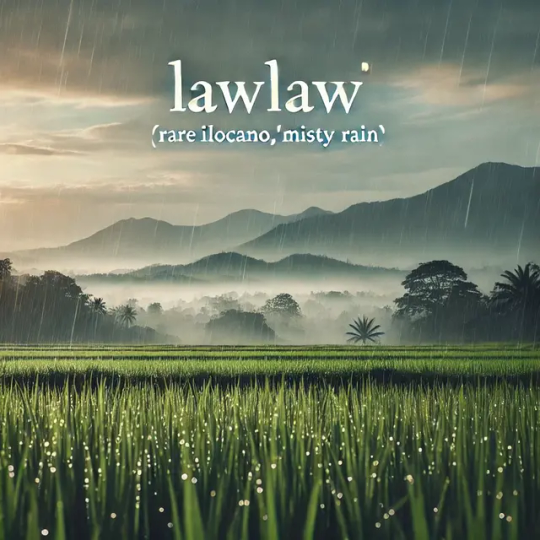
3. Sangab – The act of catching or intercepting something in the air before it falls.
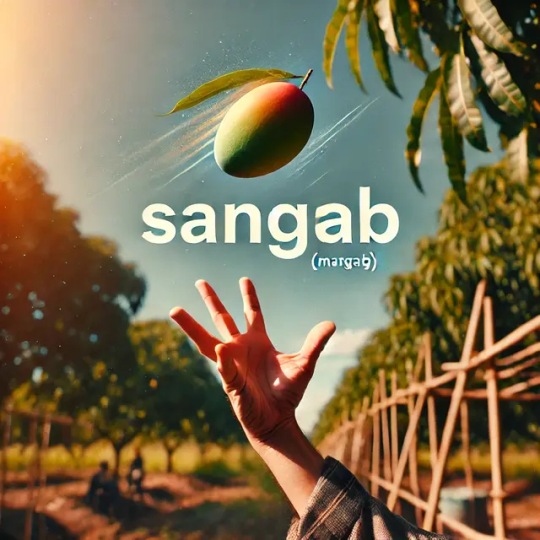
4. Riit – A creepy or eerie feeling, especially when alone or in a dark place.

5. Karkarma – The slight trembling or shaking of the body due to exhaustion or emotion.

6. Tagipusuon – The deep, emotional core of a person; the seat of emotions.
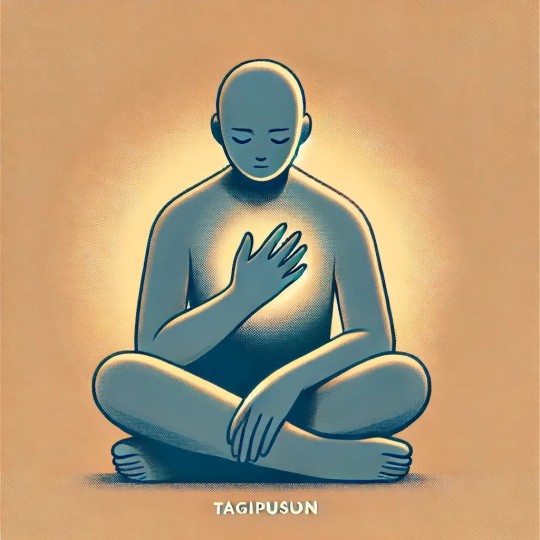
7. Dardarepdep – The rapid blinking of the eyes due to strong light or irritation.

8. Pannao – A fleeting moment or an opportunity that passes quickly.
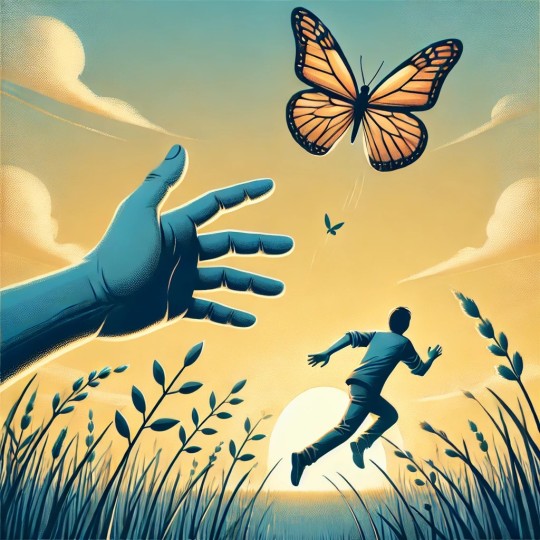
9. Agsinnublat – The act of changing clothes multiple times in a short span.
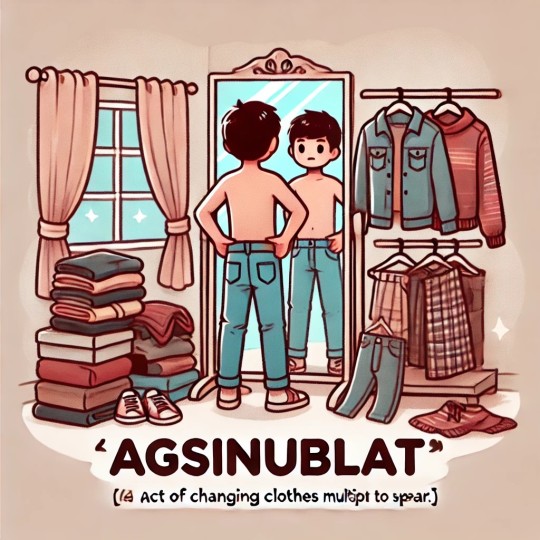
10. Lingling-ay – A term for a lullaby or soothing song, usually for children.
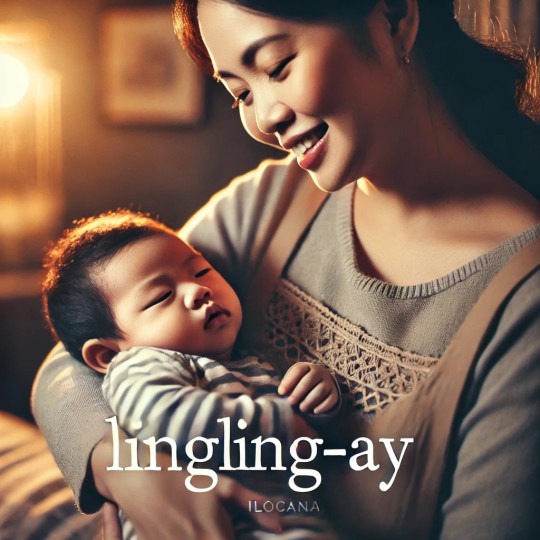
Here is the full video
https://youtu.be/6pbbKfPR7T8?si=RdyUy5bbagLDEPaG
2 notes
·
View notes
Text
Please note that the families listed here were chosen purely by number of speakers, as those would be the most likely to be spoken. There are still MANY more language families not listed
Some of these have over a thousand languages so I cant list all of them, but I'll list a few languages from each family and the generam geography of it under the cut
Austronesian
Languages spoken mostly in Southeast Asian archipeligos including Indonesian, Malay, Javanese (NOT Japanese), and Tagalog, among others
Sino-Tibetian
Languages spoken mostly arround East and Southeast Asia along with some parts of Central Asia including Chinese (all dialects), Burmese, Tibetic languages, and Nepali, among others
Indo-European
Languages spoken mostly around Europe and South-Southwest Asia including English, all romance languages, Greek, Albanian, German, Hindi, Bengali, and Sanskrit, among others
Afro-Asiatic
Languages spoken mostly around Northern ans Northeaster Africa, and West Asia including Egyptian, Hebrew, Arabic, Amharic, and Hausa, among others
Fun fact! When counted as a single language, Arabic alone is spoken by over half of the native speakers of Afro-Asiatic languages
Atlantic-Congo
Languages spanning most of Africa exclusing Northern parts including Fula, Wolof, Swahilli, Kirundi, Luhya, Makua, Xhosa, and Shona languages, among others
Fun fact! This family has the most languages of any language family at 1,453 total!
Dravidian
Languages spoken mostly in souther India, along with surrounding countries, including Telugu, Tamil, Kannada, Malayalam, and Brahui, among others
Turkic
Languages spoken in many countries throughout (mostly central/centeal western) Asia and Eastern Europe including Turkish, Azerbaijani, Uzbek, Uyghur, and Kazakh, among others
Fun fact! While we mostly think of Turkic languahes being from Eastern Europe and Central Asia, Proto-Turkic actually originates from East Asia around China and Mongolia! It's seldom spoken there anymore
Japonic
Languages spoken mostly in Japan (Note: NOT including the Ainu languages) including Japanese, Ryukyuan, and Hachijō, among others
Fun fact! Japanese was considered an isolate language (a language with no other languages in its family) until the Ryukyuan languages joined it in the Japonic family.
It also has the lowest number of languages of the ones listed, with 13 languages.
Should Koreanic have made it onto the list (It was JUST bekow Kra-Dai for # of speakers), that would be the lowest with only 2 languages!
Austroasiatic
Languages spoken mostly around South through East Asia Including Vietnamese, Khmer, Tagalog, among others
Fun fact! Two-thirds of people who speak an Austroasiatic language speak Vietnamese
Kra-Dai
Languages spoken mostly in Southeast Asia and Southern China including Thai, Lao, Bê, among others
#I spent an unreasonable amount of time on this#I KNOWWWW this poll is gonna be dominayed bt indo-european but
50 notes
·
View notes
Text
Throughout Time & Space - Modern Jewish Languages (19 Shevat)
Everyone has heard of Hebrew, the official language of the Jewish people. With over 9 million speakers and 7 million learners, it is certainly the most important and well-known Jewish language as well. However, it is by no means the only one! Many Jews do know that there are other some Jewish languages besides Hebrew, such as Yiddish and Ladino, but did you know that there are actually dozens of other Jewish languages in 7 different language families that are still spoken to this day!? In this week’s edition of Throughout Time and Space, you will be introduced to the most widely spoken Jewish language from each of these 7 families, and the history and culture behind them.
Afro Asiatic: Hebrew. Well, I did just say that Hebrew is the official language of the Jewish people, and the one with the most speakers by far, so it makes sense that Hebrew would be on the list. The Afro-Asiatic language family contains all of the Semitic languages, such as Hebrew and Arabic, as well as the vast majority of North and Northeast African languages. However, Hebrew is by far the most unique language out of any of them, as it is the only language in all of human history to be brought back from the “dead”, meaning that Hebrew is the only language to ever regain native speakers after having none at all for thousands of years. Of course, it is no coincidence that this has only ever happened to the language of Hashem’s chosen people!
Austronesian: Judeo-Malay. Judeo-Malay is (or, was, as it may have recently gone extinct) the only Judeo language in the Austronesian language family, which includes a huge diversity of languages from Maritime Southeast Asia. It is spoken by Jews in the Northern Malaysian state of Penang, and is very closely related to the Malay language of that same region. All surviving manuscripts in this language exist in the notebook of Rahamim Jacob Cohen, an Iranian Jew, and are currently being kept by the British Library.
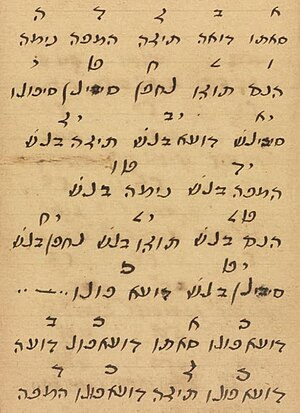
Dravadian: Judeo-Malayalam. Judeo-Malayalam is also the only Judeo language in its language family (the Dravidian family, spoken in southern India and Sri Lanka), and is spoken by the Cochin Jews (the oldest Jewish community in India, perhaps tracing back to the time of King Solomon) in both Israel and Kerala India. Since this language is extremely similar to Malayalam, it is considered by some to be a “dialect” rather than a language, but some argue that there are enough Hebrew loanwords and unique features in Judeo-Malayalam for it to be considered a unique language. Unlike other Judeo languages, Judeo-Malayalam is not written using the Hebrew alphabet. Unfortunately, this Judeo language may not be around for much longer, as the vast majority of its speakers now live in Israel, where they mainly speak Hebrew. Indo-European: Yiddish. Yiddish is perhaps the most well known Jewish language aside from Hebrew, as it was the primary Jewish language in Europe until very recently. However, it is certainly not the only Judeo language in its family. The Indo-European language family also includes the somewhat well known Jewish language of Ladino (also known as Judeo-Spanish), as well as dozens of lesser known languages such as Judeo-Persian (Jidi), Judeo-Portuguese, and Judeo-Italian. Yiddish originated in what is now Germany as a West Germanic dialect, but quickly became a language in its own right. Although many of Yiddish’s speakers were murdered in the holocaust, it is by no means an endangered language. Every year, the number of Yiddish speakers actually increases (it’s currently at about 1 million) due to its use as a primary language in Haredi communities in pretty much every country with Haredim. Many famous Jewish authors, such as Shalom Aleichem, have written in Yiddish.

Kartvelian: Judeo-Georgian. Judeo-Georgian (called Qivruli in the language itself) is one of two Kartvelian (South Caucasus) Judeo languages, the other being Judeo-Mingrelian which is nearly extinct. However, Judeo-Georgian actually has about 60,000 native speakers! It is spoken by Jews who live in the country of Georgia, a community which has been there for 2,600 years after escaping Babylonian captivity. Although Judeo-Georgian is mutually intelligible with Georgian, it has enough Hebrew loanwords to be considered its own language (a similar situation to Ladino and Spanish, or even Yiddish and German). The language is written using the Hebrew alphabet.

Turkic: Krymchak. Krymchak is spoken in Crimea in the Krymchak community, which is mostly composed of Jewish immigrants. The language shares a lot of similarities to Crimean Tatar, which is the dominant language of the region. However, Krymchak is considered a language in its own right due to the amount of Hebrew loanwords it contains. In the past, the language was also written using Hebrew letters, but it is now written using Cyrilic (and during the time of the Soviet union was written in a modified Latin alphabet). Although this language once had quite a number of native speakers, it is now nearly extinct, with fewer than 800 speakers in Crimea and a couple thousand worldwide. There are single digit numbers of native speakers.
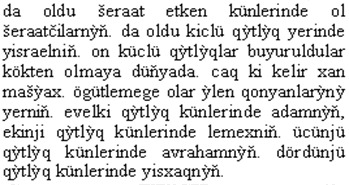
Creole: Judeo-Papiamento. Judeo-Papiamento is a Jewish language with its roots in the Portuguese-based creole (creoles are languages that are formed by two or more distinct languages combining and simplifying. Many, including this one, were formed during the colonization of the Americas) language of Papiamento. The language was first spoken by Sephardic Jews in Curacao, which is where it is still most commonly used to this day. Judeo-Papiamento differs from Papiamento as it contains many Hebrew loanwords and is also pronounced slightly differently. Judeo-Papiamento is the only living Jewish creole language and also the only Jewish language with any ties to the Netherlands.
So, that was your first glance at Judeo languages across the world. The fact that Jews speak so many languages in so many different language families all across the world is truly a testament to how long we have been living in exile. However, the fact that many of these languages are now dying is a testament to another form of Jewish resistance. We no longer need to continue speaking languages tainted by our exile, as we have now revived the language of our ancestors for our children to become its native speakers. Normally, it is sad when languages die, but these languages are not dying because their speakers are dying - they are being laid to rest because their speakers are finally returning home to their motherland and mother tongue. Although these languages are fascinating to learn about, Iy”H they will soon be relegated to the history books while the people of Israel live.
Tell me in tags: How many of these languages have you heard of before? How many do you speak? Are you also a Hebrew speaker? Let me know in the tags!
Jew Joke:
What does a kvetcher always have for breakfast?
A (com)plain bagel.
4 notes
·
View notes
Text
Tossing phonemes overboard
Every time the ancient Polynesians hopped in a boat and sailed to a new set of islands they tossed another phoneme overboard:
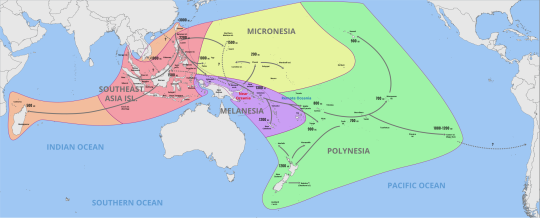
Map showing the dispersal of the Austronesian languages, of which the Polynesian languages are a part. The family starts in Taiwan and spreads westward to Madagascar and eastward to the Polynesian islands.
Arranged roughly in order of dispersion from Proto-Polynesian:
Gorontalo: 20 consonants, 5 vowels
Sam: 17 consonants, 5 vowels
Siar-Lak: 15 consonants, 7 vowels
Longgu: 18 consonants, 5 vowels
Toqabaqita: 17 consonants, 5 vowels
Vurës: 15 consonants, 9 vowels
South Efate / Nafsan: 15 consonants, 5 vowels
Tuvaluan: 11 consonants, 5 vowels
Samoan: 10 consonants, 5 vowels
Tokelauan: 10 consonants, 5 vowels
Tahitian: 9 consonants, 5 vowels
Rapa Nui: 10 consonants, 5 vowels
(Yes these data are incredibly cherry-picked. Nonetheless, there is a known correlation between the eastward spread of the Austronesian and Polynesian languages and their decreased phoneme inventories. Whether this is just a coincidence or a matter of broader demographic influences on language is still a matter of debate among linguists.)
28 notes
·
View notes
Text
it’s still mind blowing to me that indigenous taiwanese people and ryukyuans are not related. how close taiwan and the ryukyu islands are, yet they don’t speak the same language family nor are they even descended from the same ancestral stock. taiwanese aboriginals came from pre-austronesians in mainland china (presumably the yangtze where the austronesian-associated haplogroup was found) whereas ryukyuans are descended from native jomon and yayoi people from the korean peninsula.
16 notes
·
View notes
Text
admittedly i dont really see it talked about much whatsoever, but it's always either 'taiwan is chinese' or 'taiwan is taiwanese'. never do see 'taiwan/china out of formosa'. never see mention of the greatest diversity of austronesian languages, many under threat of extinction, that all but one of the branches (malayo-polynesian) of the austronesian language family are exclusive to the island, that the entire family is believed to have originated on the island.
7 notes
·
View notes